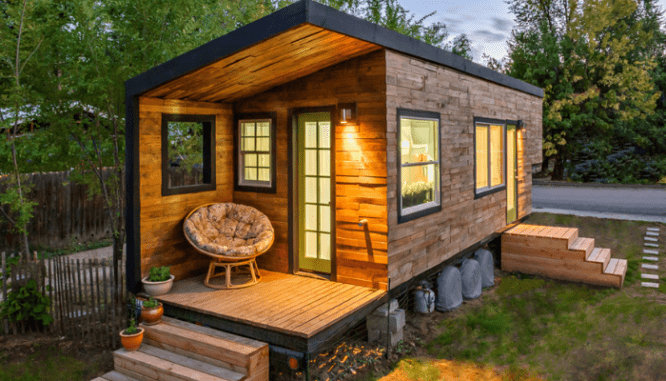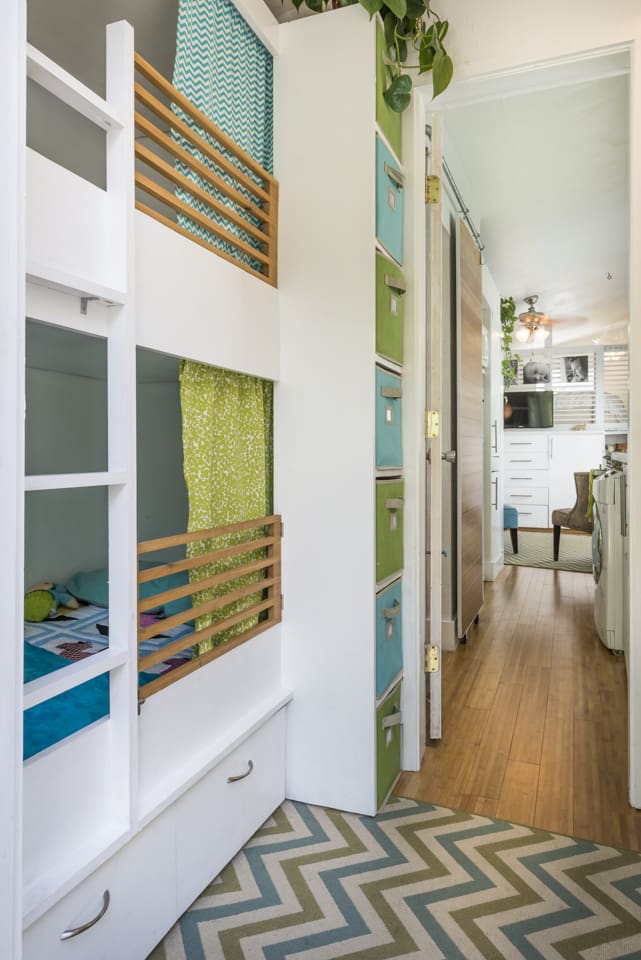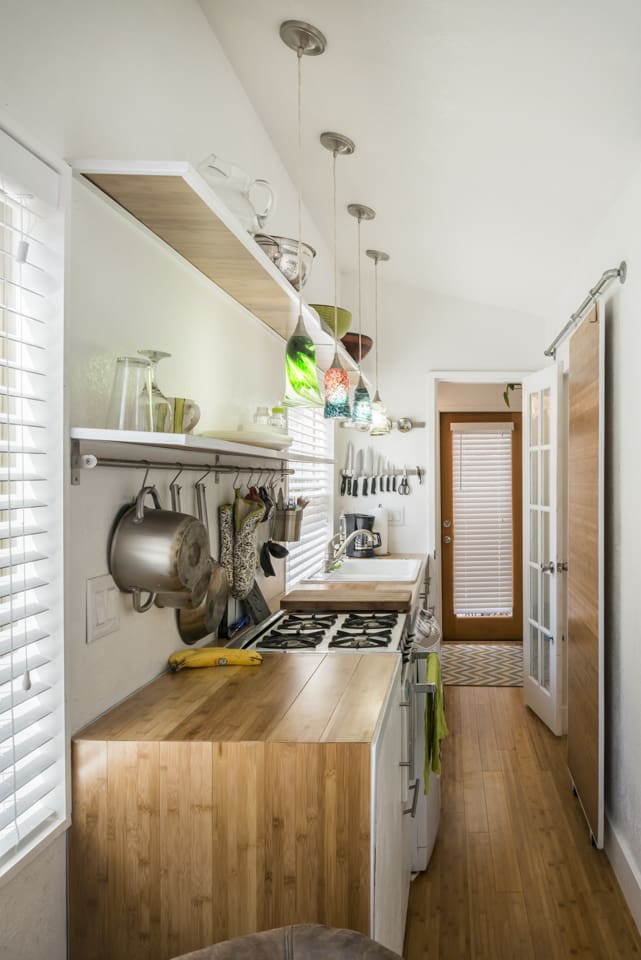The Truth Behind Tiny House Living: How Four People and Two Pets Live Large in 232 Square Feet
- Published on
- 3 min read
-
 Kaitlynn Copinger Contributing AuthorClose
Kaitlynn Copinger Contributing AuthorClose Kaitlynn Copinger Contributing Author
Kaitlynn Copinger Contributing AuthorKaitlynn Copinger is a freelance writer based in Virginia Beach. She is a former newspaper reporter with more than a decade of professional writing experience. Having bought and sold one house, then relocating and purchasing another, Kaitlynn knows well the challenges and joys of home ownership.
There’s something downright adorable about a tiny house. These extra-small homes, stationary or mobile living spaces that range from 100 to 400 square feet, are also an appealing option for people eager to live a minimalist lifestyle.
Thanks to the internet, you could spend all day looking at tiny house floor plans and photos, daydreaming about downsizing your living space and rightsizing your life. But the best way to learn the truth behind tiny house living? Ask someone who lives in a tiny house.
On that note, meet Macy Miller, a tiny living enthusiast and advocate who shares a 232-square-foot home in Idaho with her partner, two kids, a dog, and a cat. She’s lived in her tiny home for nearly a decade and has watched the tiny house movement grow from one cloaked in obscurity to celebrated on HGTV.
“Just the whole tone around tiny homes has changed,” she says. “It’s almost cool and popular, which is not what it was 10 years ago. But it is a good way to live. Cream rises to the top, in my opinion, and I wouldn’t change it for the world.”

A tiny house origin story
Miller has not always been a tiny house dweller. Before she made the transition, she lived in a 2,500-square-foot Boise, Idaho, house, making it just a bit larger than the 2,261 square feet that 2020 U.S. Census data says is the median size of a single-family home. But she hated it from the start. With three unused bedrooms, it was simply too large. Her monthly utility bills only added insult to injury.
“My utility bills used to be $600 a month, for heating and cooling for space I barely used,” she says.
Then came a global financial crisis, a divorce, and Miller’s desire to avoid taking on a large mortgage. Miller, who was educated and trained as an architect, decided to use her skills to design and build a tiny house for less than $12,000, a journey she chronicled on her website, MiniMotives.com.
She started construction in 2011 on a 196-square-foot house that could accommodate two adults and a Great Dane. In June 2013, she moved in, thinking it would be her primary residence only for a short time. But it turned out to be a good fit, and nearly a decade later, she still calls her tiny house home.
“It just flowed,” she says. “It just made so much more sense for my life than that 2,500-square-foot house did.”
A tiny house tour
One of the things that attracted Miller to tiny house living was the mobility of it. When she set out to build her tiny home, she put it on a gooseneck trailer, which came in handy when her family relocated from Boise to Moscow, Idaho (more on that later).
On her website, Miller recently posted a video tour of her home, which starts in the living room, containing a couch and a TV — and Denver, the Great Dane. “Denver wants to be within 3 feet of me at all times, which works out well in a tiny house,” Miller tells HomeLight.
Next to the living room, and up some stairs, is the sleeping loft Miller shares with her partner, James. Beside the loft and throughout the house, discrete storage areas hide items like winter coats, holiday decorations, and kids’ games.
A galley kitchen includes counter space, shelving for dishware, a sink, stove, refrigerator, and microwave. It’s also where the washer/dryer is located. The house’s one bathroom has a large shower, a sink and a composting toilet.
At the rear of the house, what was originally a patio is now the bedroom for Miller’s two children, ages 7 and 5. When her second child was born, Miller enclosed the patio to create a bedroom with a bunk bed-like arrangement, increasing the size of the house by 36 square feet.
“There’s four people in 232 square feet, but we get along pretty well,” Miller says. In fact, she credits the smaller space with creating deeper family bonds.

Making a big move
Like many tiny home dwellers, Miller’s journey has included significant zoning and location challenges. Her home’s initial location was a residential area in Boise. Since Boise’s zoning rules did not allow for a house her size, Miller spoke to her neighbors first to make sure they were ok with her being in the neighborhood.
Boise was her family’s home for nearly five years. Then, the family took to the road for a year in a 84-square-foot camper to tour the National Park system — but that’s a whole different story! When they returned, they decided Boise was no longer a good fit.
In May 2019, the family purchased a 6-acre plot of land in Moscow, Idaho, about 300 miles north of Boise. They relocated their tiny house and have begun creating a homestead. About a year ago, Miller’s tiny house finally received legal status, through a conditional use permit that gives her property the official zoning designation of a single-space RV park.
“I much prefer being legal,” she says.
Going off grid
The move also gave Miller the opportunity to achieve another personal goal: going off grid. While much more challenging than the steps an average homeowner takes to connect to the municipal grid, going off grid can significantly lower utility costs.
Most of Miller’s tiny house’s power comes from solar energy, obtained through a 2,500-watt solar array. They also have a backup generator that they use a couple times a year. To survive Idaho winters, the family alternates between three heat sources: an electric mini split, an electric convection heater, and a gas heater.
To maintain a water supply, they built a shed next to their house that stores about 900 gallons of water (as well as extra food items, toiletries, and work space for Miller and James). They also built a barn nearby, with a slanted roof that enables them to collect rainwater from the sky.
As for internet access, they use a mobile hotspot. “It works great, and then we both operate our business from home, so, so far, so good,” Miller says.

A minimalist approach to life
On her video tour through her home, Miller points out the family’s four coffee mugs — one for each person. “We have four forks, and four spoons,” she says in an interview. “That’s just how we roll. It’s great.”
Take a look through the many blogs, websites, and Instagram accounts dedicated to tiny house living, and it’s clear that the housing choice is not just about square footage. It’s a way of life. For many people, being so constrained by what they can buy and store would be a challenge. But Miller has embraced the lifestyle.
“I’ve been a minimalist since the day it was born, so it was an easy transition,” she says.
Living in a tiny house makes it financially possible for her to homeschool her kids and for the family to spend more time together, she says. She gets to pick the projects she works on, like writing about tiny house living and connecting with other tiny house enthusiasts through her Facebook group, Tiny House People, which has more than 45,000 members.
“If we were still living in a suburb, I’d have 20 years on my mortgage still,” she says.
Slightly bigger plans for the future
The tiny house is not her forever home, Miller says. She and James have discussed plans to build a passive house on their property. It will still be small, about 600 to 800 square feet, but it will give her kids enough space to have their own bedrooms by the time they are teenagers. The tiny house isn’t going anywhere, however. Miller says they would like to rent it out to give other people the experience of tiny house living.
For now, though, it works for Miller and her family, which as of last summer also includes Ginger the orange tabby. They continue to enhance the house and their Moscow property, ongoing work that Miller chronicles on her Instagram account, @whatifworkshopIdaho. One project on the docket for next summer: building a covered outdoor seating area.

Advice from an experienced tiny house resident
There’s no question that a tiny house is not the right choice for everyone, Miller says. A lot of people would not be able to handle living in such a small space, let alone with others. When she speaks to people about making the transition, they often cite barriers as to why they cannot make it work. Her encouragement? Keep an open mind.
“Living in a tiny house is not about limiting what you want from life; it’s about getting real clear about it,” she says.
Write down what’s important to you, then decide how to fit it into your life, she says. “Anything is possible in a tiny house,” she says. “If you give a little here, you might have to take a little there. And you just have to find a balance.”
Remember: You can think of your move into a tiny house as a stepping stone. It doesn’t have to be your forever house, she says. Even those who do not want to downsize can still “appreciate living lighter” — and all the benefits that come with that.
“We cannot keep up with the Joneses. They don’t exist. And yet we all try,” says Miller.
“And it’s really freeing once we buck that system.”
A tiny house of one’s own
If Miller’s tiny house, and her tiny house lifestyle, sound appealing, then maybe it’s time for you to live larger by turning tiny. A top-rated HomeLight agent can help, whether you’re looking for 300 square feet or 3,000. Get in touch, and we can help you appreciate the little things in life.
Header Image Source: (Macy Miller of MiniMotives.com)
